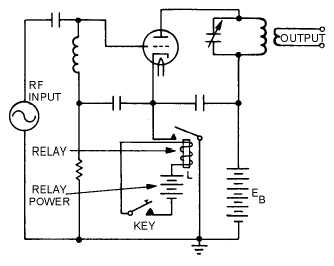1-31
When greater frequency stability is required, the oscillator should not be keyed, but should remain in
continuous operation; other transmitter circuits may be keyed. This procedure keeps the oscillator tube at
a normal operating temperature and offers less chance for frequency variations to occur each time the key
is closed.
KEYING RELAYS.—In transmitters using a crystal-controlled oscillator, the keying is almost
always in a circuit stage following the oscillator. In large transmitters (75 watts or higher), the ordinary
hand key cannot accommodate the plate current without excessive arcing.
WARNING
BECAUSE OF THE HIGH PLATE POTENTIALS USED, OPERATING A HAND
KEY IN THE PLATE CIRCUIT IS DANGEROUS. A SLIGHT SLIP OF THE HAND
BELOW THE KEY KNOB COULD RESULT IN SEVERE SHOCK OR, IN THE
CASE OF DEFECTIVE RF PLATE CHOKES, A SEVERE RF BURN.
In larger transmitters, some local low-voltage supply, such as a battery, is used with the hand key to
open and close a circuit through the coils of a KEYING RELAY. The relay contacts open and close the
keying circuit of the amplifier. A schematic diagram of a typical relay-operated keying system is shown
in figure 1-25. The hand key closes the circuit from the low-voltage supply through the coil (L) of the
keying relay. The relay armature closes the relay contacts as a result of the magnetic pull exerted on the
armature. The armature moves against the tension of a spring. When the hand key is opened, the relay coil
is deenergized and the spring opens the relay contacts.
Figure 1-25.—Relay-operated keying system.
KEY CLICKS.—Ideally, cw keying a transmitter should instantly start and stop radiation of the
carrier completely. However, the sudden application and removal of power causes rapid surges of current
which may cause interference in nearby receivers. Even though such receivers are tuned to frequencies far
removed from that of the transmitter, interference may be present in the form of "clicks" or "thumps."
KEY-CLICK FILTERS are used in the keying systems of radio transmitters to prevent such interference.
Two types of key-click filters are shown in figure 1-26.

